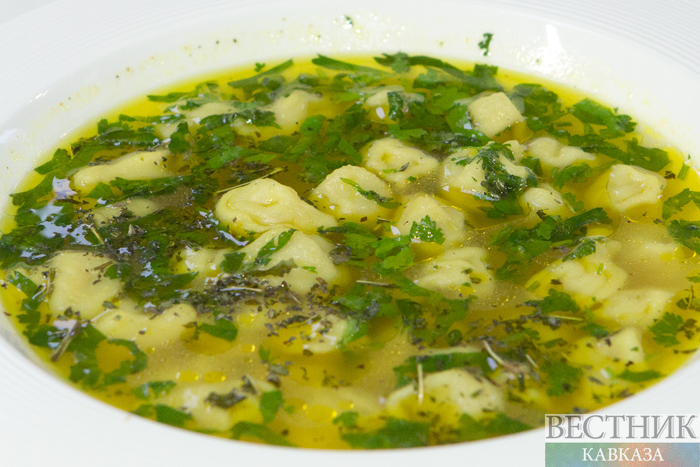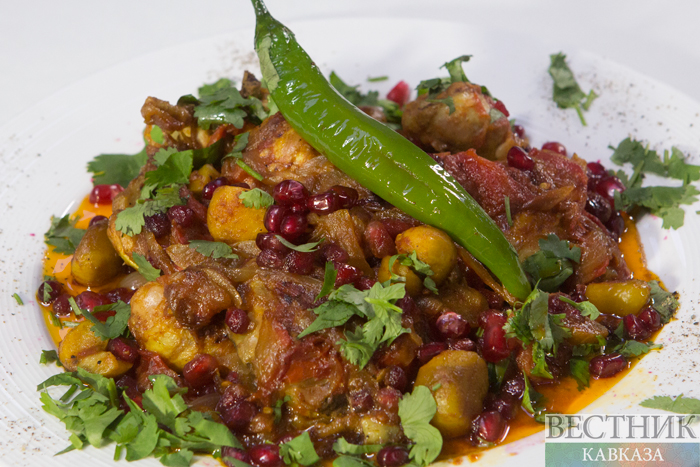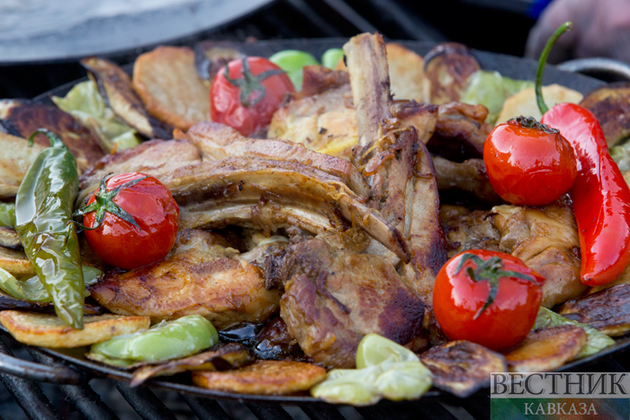The Azerbaijani table is a colourful amalgamation of dishes and ingredients — some fiercely local, some influenced by years of Turkic, Anadolu, Iranian and Eastern European influence, National Geographic writes. The country’s nine climactic zones gift the people with a bounty of fresh produce — including peaches, pomegranates, apples, figs, saffron and sweet peppers. While sheep and cattle raised on the steppe contribute meat and dairy, a variety of fresh seafood is drawn from the Caspian Sea, and vast grasslands and a rice belt furnish the country with its grains.
Saffron-infused plov (pilaf), the king of Azerbaijani cuisine, is always centre-stage, its courtiers a cast of grilled kebabs, skewered meats, dolma and cold salads. These are often accompanied by a glass of Azerbaijani wine or sherbet, a refreshing soft drink made with lemon, sugar, saffron and fresh fruit. Meals are traditionally bookended with black tea served in rosebud-shaped armudu glasses, which locals drink with a slice of lemon.
The country’s food traditions coalesce in its capital, Baku, where restored caravanserais (roadside inns along the historic Silk Road trade route) house trendy restaurants. Meanwhile, a journey to the regions reveals a landscape of dishes served the old-fashioned way in bowls of copper and clay: from cured meats in the mountains to seafood on the coast.
1. Dushbara (Baku)
Dushbara — Azerbaijani dumplings — have Turkic origins and are similar to tortellini. They’re devoured all over the country but are particularly popular in, and hail from, the capital Baku. Paper-thin dough — cut precisely into three-centimetre squares — is filled with a mixture of ground lamb or mutton flavoured with mint, garlic and onions. The dumplings are boiled and served in a translucent bone broth with crushed garlic, vinegar and yogurt on the side. Pinching the miniscule dumplings into shape is an art that can take a lifetime to perfect — cooks are judged on the size of their dushbara, with decorum dictating that a dozen tiny dumplings should fit onto a single soup spoon.

2. Lavangi (Lankaran)
Sandwiched between the mountains and the sea, Lankaran is known for its distinct cuisine that marries local Talysh and classic Azerbaijani dishes: notably kuku, an onion omelette served with flatbread and plov prepared with pumpkin. Lankaran’s most iconic food export is lavangi, a dish of either fish or chicken stuffed with a mix of walnuts, raisins, onions, sumac, alcha (green cherry plums) and narsharab (pomegranate molasses) that when combined, create a sweet-sour flavour and a medley of textures. It’s difficult to come by lavangi in restaurants; this meal is usually reserved for Novruz, Azerbaijan’s most important national holiday that ushers in the start of spring. As part of the Novruz tradition, extended families gather around the table to feast, a symbolic act that represents a year spent together.
3. Piti (Sheki)
Azerbaijan has more than 30 regional soups to its name, each served in a distinct vessel. Piti takes its name from the glazed earthenware pot it’s cooked and served in. Slow food at its finest, it’s traditionally simmered for at least nine hours. The main ingredients are mutton, chickpeas, potatoes and tomatoes, while the mellow flavour profile comes from saffron-infused water and dried cherry plum. The not-so-secret ingredient is a lump of salted fat, which renders down to give the soup a rich texture. Once at the table, piti is eaten in two parts. First, one must place pieces of torn bread in a bowl, dust them with sumac and, using the back of a spoon as a strainer, pour over the soup from the piti pot. What’s left is eaten as a second course. The best place to try piti is in the region of Sheki, the spiritual home of the dish, where chestnuts are used in place of potatoes.
.jpg)
4. Govurma (Nakhchivan)
Fertile Nakhchivan has long been associated with bountiful herb gardens and fruit orchards. Below the surface, natural mineral springs and underground salt deposits have inspired a culture of self-sufficiency and resourcefulness based on food preservation. Govurma is made during spring and summer to see families through the long winter. Large chunks of veal or lamb are strung up and dried for 24 hours, salted, stewed, then fried off in oil. The meat is then transferred into ceramic jars and covered in either melted butter or mutton fat. After four to eight weeks, it’s ready to eat. Many local dishes use govurma, including govurma shorbasi (lamb stew), where the aged meat is combined with fresh beans and potatoes, and bezirgani, a winter soup with tomatoes, onions and egg. The Nakhchivian tradition of preserving meat dates back to at least the 15th century and is mentioned in the Book of Dede Korkut, an epic that describes the old ways of the Azerbaijanis’ nomadic ancestors.

5. Surhullu (Gakh)
Surhullu belongs to the mountainous region of Gakh, where long, unforgiving winters in the Greater Caucasus have inspired a tradition of hardy peasant fare. This dish comprises protein (either fresh lamb or jerked meat prepared the previous spring) served atop a bed of ‘pasta’, which is made by hand-rolling dough across a wooden board. It’s this process that gives surhullu, which means ‘rubbed’, its name. The pasta is boiled in a rich broth until tender before being dressed with garlic. Surhullu is eaten throughout north-western Azerbaijan and is easy to find at restaurants and guesthouses. In the village of Ilisu, where meat-drying traditions run deep, the pasta is served in its meaty broth and finished with a piquant plum sauce.
6. Shah Plov (Ganja)
Alexander the Great might take the credit for inventing plov — legend has it the military leader relied on it to feed his hungry troops — but Azerbaijanis have well and truly embraced this rice-based dish and made it their own. Today, this aromatic one-pot wonder is considered Azerbaijan’s national dish, made according to at least 40 regional recipes, but said to come in as many different versions as there are people who cook it. Basic plov is made by layering steamed basmati or locally grown baltali rice with dried apricots, plums, raisins, chestnuts and chunks of lamb or beef. Azerbaijan’s second-largest city, Ganja, takes plov a step further: for their signature version, shah plov (‘king’s plov’ or ‘crown’s plov’), the pilaf is wrapped in a cocoon of flatbread that turns into a crisp shell, called a gazmakh, when baked. Shah plov is often served as the main course at weddings and prepared for Novruz, but it can also be eaten year-round in restaurants in Ganja and beyond.
.jpg)
7. Kata (Karabakh)
Somewhere between a dense bread and a pie, kata is a sweet short pastry made with generous amounts of butter, sugar and ghee. Every region has its own kata, distinguished by shape and filling, but the most beloved rendition of this calorie-rich, nostalgic treat comes from Karabakh in the southwest of Azerbaijan. Inside, the kata has a thin layer of sugar, butter and flour crumb, sometimes gently perfumed with a touch of vanilla or lemon zest. Karabakh kata is presented as a large disc, egg-washed and baked until the crust is the colour of golden syrup. Before it hits the oven, the top is scored with a fork. On special occasions, more elaborate designs are created by etching or layering pieces of dough on top. Kata is sold at bakeries across Azerbaijan and is normally eaten warm for breakfast or afternoon tea. In mountainous Karabakh, families might take advantage of seasonal greens to prepare a savoury kata filled with nettle, spring onions or spinach. In this case, this dish is paired with ayran, a popular soured milk drink.






